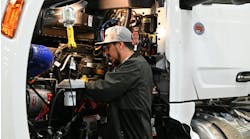Rebecca Bird
Product Marketing Manager
Isotrak (www.isotrak.com) is a global fleet management software and service provider.
When it comes to fleet maintenance issues, the major pain point that every back office can attest to is downtime. Historically, fleets and technicians relied on drivers upon their return from a completed trip to manually report any diagnostic trouble codes (DTCs) which may have lit up the dashboard during only a portion of their trip.
Manual processes like these leave room for error. For example, a driver may be in a hurry to get home after finishing his or her shift and forget to alert the office about a DTC that might have popped up while they were driving.
This could cause a potential maintenance issue to go unaddressed. Unforeseen problems can cause unplanned downtime or even a breakdown.
Downtime like this can be avoided. The key is to shift your mindset from being reactive to proactive in identifying potential issues and taking steps to prevent them from becoming problems. Fleet telematics and software solutions have evolved to the point where drivers and transport offices can seamlessly exchange information across streamlined platforms, such as Isotrak’s ATMSi solution, which provides greater insight into fleet operations, driver performance and vehicle status.
While fleet telematics and software solutions are currently giving back office managers the transparency they need to confidently run their operations, it’s even more exciting to look to the future and see how evolving technology will further affect maintenance procedures, and perhaps even expand beyond to nurture better driving habits.
Today
The great thing about technology and telematics today is that it they can be updated to meet changing business or legislative landscapes. For example, Driver Vehicle Inspection Report (DVIR) mobile apps that drivers can use to conduct and submit pre- and post-trip vehicle inspection reports directly from their mobile devices can be customized to focus on particular items.
Managers can view these reports in real-time as they’re uploaded, allowing earlier detection of potential issues and prioritization of necessary repairs. Take tires, for instance. With daily updates to tread depth, the back office can accurately track wear and tear to determine whether a new set of tires is required now or on a future date.
Regardless of the issue, trucks and trailers can be flagged for further inspection or maintenance when they arrive at their final destination. Incorporating this data into a maintenance calendar leads to more accurate resource allocation, and technicians can even ensure their inventory of parts is properly stocked so that vehicles can be on the road when they need to be.
Tomorrow
Increased transparency into vehicle status is only the tip of the iceberg. As mobile software solutions become more integrated with telematics systems, platforms are connecting directly with black boxes to register DTC alerts and automatically notify back offices of an impending maintenance issue, rather than waiting on administrators to view Driver Vehicle Inspection Reports. If a vehicle breaks down on the side of the road, technicians can interrogate the engine and take necessary action, such as requesting dispatch of proper repair crews with the right parts directly to the sidelined vehicle.
Other problems that may occur, but don’t inhibit the vehicle’s operation, could be prioritized based on a pre-set maintenance calendar so the critical items are flagged for immediate examination or logged and scheduled for a future inspection, all without requiring manual input.
Analytics tracked by telematics platforms are also reaching the point of assisting with driver training. An intelligent system could alert the back office if a particular issue continues to occur during the shift of a specific driver. Rather than continuing to conduct maintenance to correct the issue, these insights could identify a particular driving habit that, if corrected, could keep the vehicle on the road longer and in the shop for fewer maintenance periods.
The future of fleet telematics is only going to further empower drivers and the back office with the information they need to proactively address maintenance and safety issues. Whether that course of action is ordering a new part or educating a driver to improve their driving habits, it’s ultimately all about reducing unnecessary downtime for the fleet.




